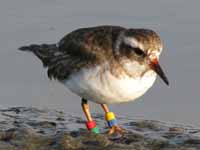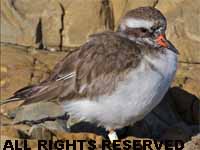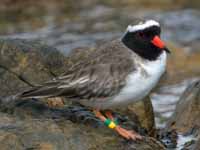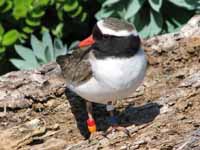THE WORLD BIRDS - An Online Bird Book
SHOREBIRDS
Small Plovers
Order Charadriiformes Family Charadriidae
SHOREBIRDS
Most Shorebirds walk along shores probing for food with their thin sensitive bills. Bill length varies considerably so differing species can work the same shore and obtain different
food supplies. Shorebirds include sandpipers, godwits, stilts, oystercatchers, plovers, and many more. Shorebirds belong to the Charadriiformes order which also includes the Gulls
and Allies.
Note: the term Shorebirds is used in the Americas; elsewhere "waders" is used. We will reserve "waders" for herons and allies.
Some Charadriiformes families:
Burhinidae: thick-knees; Charadriidae: small plovers, lapwings; Glareolidae: courses, pratincoles; Haematopodidae: oystercatchers
Jacanidae: jacanas; Recurvirostridae: avocets, stilts; Scolopacidae: small bill sandpipers, large bill sandpipers
Note: the term Shorebirds is used in the Americas; elsewhere "waders" is used. We will reserve "waders" for herons and allies.
Some Charadriiformes families:
Burhinidae: thick-knees; Charadriidae: small plovers, lapwings; Glareolidae: courses, pratincoles; Haematopodidae: oystercatchers
Jacanidae: jacanas; Recurvirostridae: avocets, stilts; Scolopacidae: small bill sandpipers, large bill sandpipers
Small Plovers
Order Charadriiformes Family Charadriidae
They are small to medium-sized birds with compact bodies, short, thick necks and long, usually pointed, wings, but most species of lapwing may have more rounded wings. Their bill are usually straight and short, their toes are short, hind toe could be reduced or absent, depending on species. Most Charadriidae also have relatively short tails, the killdeer is the exception. In most genera, the sexes are similar..
Genus Anarhynchus - 1 species
Wrybill Anarhynchus frontalis Found: New Zealand
The Wrybill is the only bird species that has a beak that is bent sideways (to the right). It has pale gray upperparts, crown, wings, tail; white forehead, throat, underparts; thin black collar.
Image by: 1) 57Andrew 2, 3) Charlie Fox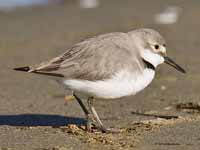
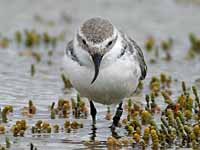
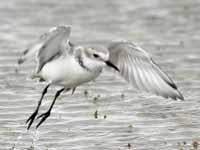
Genus Charadrius
Many of these plovers and dotterels are characterised by breast bands or collars. They have relatively short bills and feed mainly on insects, worms or other invertebrates, which are obtained by a run-and-pause technique. They hunt by sight, rather than by feel.
Dotterel,_Eurasian also Dotterel Charadrius morinellus Found: west North America (rare), Europe, Asia, Africa
The Eurasian Dotterel has a striking whitish supercilium in all plumages. Adults in summer are unmistakable, with a chestnut breast bordered above with white, black belly and warm brown back. The legs are yellow, and the short bill is black.
Similar to: nonbreeding European Golden Plover. Eurasian Dotterel is smaller and more compact than European Golden Plover.
Image by: 1) Mark Jobling 2) n kenji - Japan 3) Tony_Morris - England 4, 5) Helwig
Brunner 6) Frank Vassen - Belgium Similar to: nonbreeding European Golden Plover. Eurasian Dotterel is smaller and more compact than European Golden Plover.
1) Juvenile 2) nonbreeding
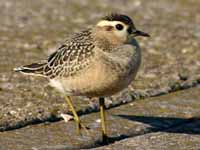
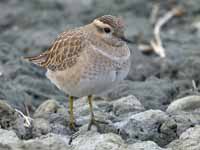
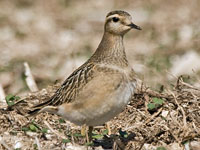
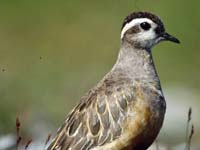
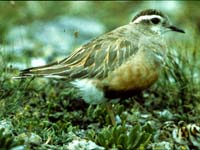
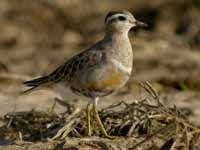
Dotterel,_Inland also Australian Dotterel Charadrius australis also Peltohyas australis Found: Australia
The Inland Dotterel has buff upperparts with some dark brown stripes; pale face with vertical black band; buff and white underparts with black Y on breast.
Similar to: Black-fronted Dotterel. Black-fronted Dotterel has horizontal black eye-line; Inland Dotterel has vertical black eye-line.
Image by: 1) Arthur Chapman 2) Francesco_Veronesi 3. 4) Brian_McCauley Similar to: Black-fronted Dotterel. Black-fronted Dotterel has horizontal black eye-line; Inland Dotterel has vertical black eye-line.
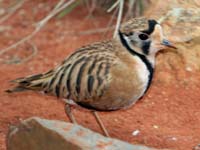
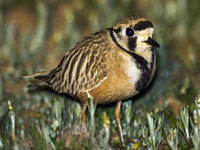
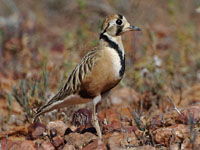
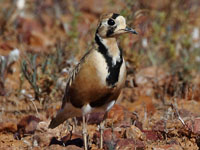
Dotterel,_New Zealand also Red-breasted Plover Charadrius obscurus Endemic to New Zealand
The New Zealand Dotterel are usually found on sandy beaches and sandspits or feeding on tidal estuaries.
Image by: 1) Piotr Zurek 2, 3)
Chris Gin on Waiheke Island New Zealand 4) Andrej_Chudy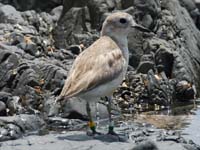

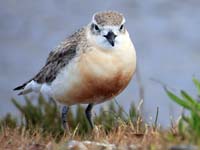
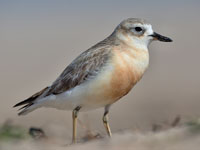
Dotterel,_Red-capped also Red-capped Plover Charadrius ruficapillus Found: Australasia
The Red-capped Dotterel has gray-brown upperparts; white underparts and forehead. Adult male has Charadrius modestus crown, forehead; breeding plumage has black border to crown and shoulder. Female has paler gray-brown crown.
Similar to: Chestnut-banded Plover. Ranges do not overlap.
Image by: 1, 3)
JJ Harrison - Tasmania, Australia 2, 4) Oystercatcher Similar to: Chestnut-banded Plover. Ranges do not overlap.
1, 2) Female 3, 4) Male
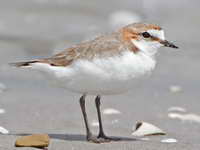
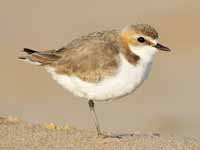
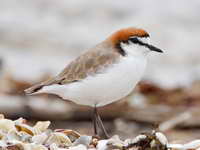
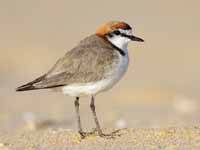
Dotterel,_Rufous-chested also Rufous-chested Plover Charadrius modestus Found: South America
The Rufous-chested Dotterel has brownish upperparts; gray face; cinnamon fore-neck and breast when breeding, brownish otherwise ; white supercilium; white belly; black bill; greenish-gray legs;
Image by: 1) Cláudio Timm - Brazil 2) Joshua Stone - Chile 3) Mark Peck 4, 5) Gunnar_Engblom1, 2) Nonbreeding 3, 4, 5) Breeding

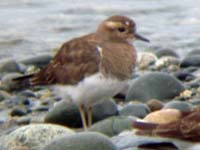
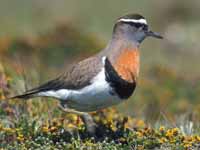
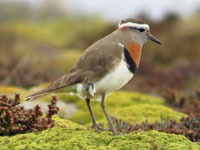
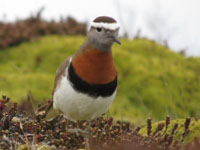
Killdeer Charadrius vociferus Found: The Americas
The Killdear has brown back, wings, crown; white forehead, neck, underparts; black neck ring; black breast arc; orange-red eye-ring.
Similar to: Three Banded Plover. Ranges do not overlap.
Image by: 1) Maggie Smith - California 2, 3, 5, 6, 8) Dick Daniels - North Carolina 4) Dick - Cape May, New Jersey 8) Dick - Puerto Rico Similar to: Three Banded Plover. Ranges do not overlap.
1) Juvenile 8) Male in breeding display.
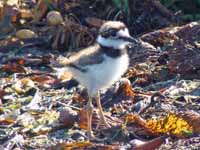
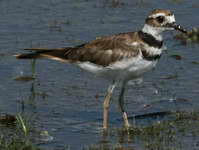

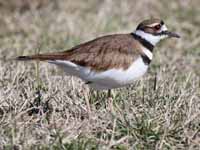
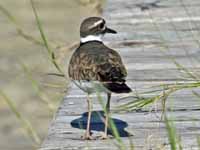

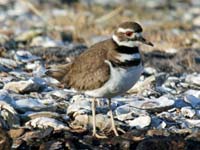
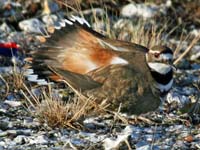
Plover,_Caspian Charadrius asiaticus Found: Asia, Africa
The Caspian Plover has a white supercilium; gray-brown upperparts; white belly. Breeding male has chestnut breast; breeding female may have hint on chestnut on breast; nonbreeding have gray-brown.
Image by: 1) Hiyashi Haka 2) Lip Kee - Kenya 3) Tsrawal 4) Marcel Holyoak - Israel 1) Female 2) Male
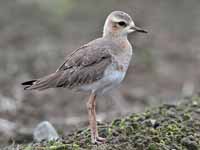

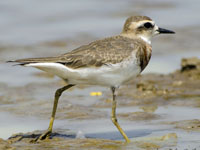
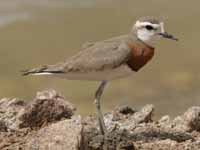
Plover,_Chestnut-banded Charadrius pallidus Found: Africa
The Chestnut-banded Plover has pale upperparts; white forehead, neck, underparts; chestnut neck band. Africa's smallest plover.
Similar to: Red-capped Dotterel. Ranges do not overlap.
Image by: 1) Trevor Hardaker - Namibia 2) Jerry
Oldenetttel - Namibia 3) Francesco_Veronesi - TanzaniaSimilar to: Red-capped Dotterel. Ranges do not overlap.
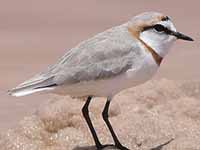
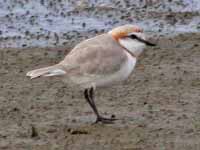
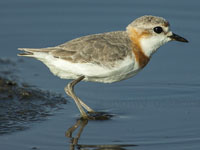
Plover,_Collared Charadrius collaris Found: Mexco to South America
The breeding Collared Plover has brown upperparts; chestnut mid-crown with black in front; white forehead, throat, underparts; black breast band. Male has black stripe from bill to eye. Nonbreeding lacks chestnut on crown.
Similar to: Semipalmated Plover. Semipalmated Plover has a thicker bill and is larger than the Collared Plover.
Similar to: Snowy Plover. Snowy Plover is paler above than the Collared Plover and has dark legs.
Image by: 1, 2) Cláudio Timm - Brazil 3) Gustavo_Duran - Argentina 4, 5) Nick Athanas - Panama, Brazil Similar to: Semipalmated Plover. Semipalmated Plover has a thicker bill and is larger than the Collared Plover.
Similar to: Snowy Plover. Snowy Plover is paler above than the Collared Plover and has dark legs.
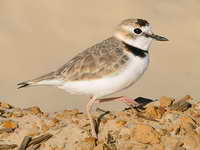
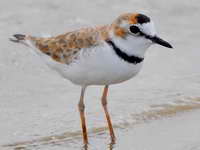
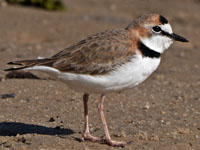

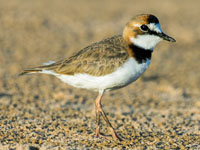
Plover,_Double-banded Charadrius bicinctus Found: Australasia
The breeding Double-banded Plover has grayish-brown upperparts; white forehead and underparts; dark neck band; wider chestnut breast band; grayish legs. Nonbreeding adult has negligible bands.
Image by: 1, 2, 3) JJ Harrison - Tasmania 4) Andrej_Chudy - New Zealand1) Nonbreeding 2) Transitioning to breeding 3, 4) Breeding
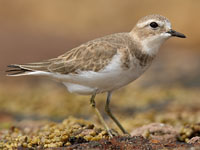
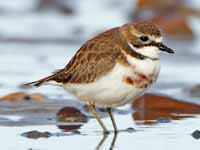
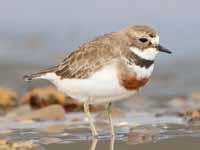
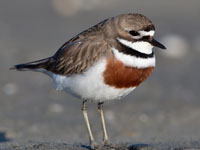
Plover,_Forbes's Charadrius forbesi Found: west Africa
The breeding Forbes's Plover has dark brown upperparts; white underparts with two black breast bands separated by white; gray crow; greenish-gray forehead, face; white supercilium extending beyond eyes to meet at back of head.
Similar to: Three-banded Plover. Three-banded Plover has white forehead; Forbes's Plover has gray forehead. Ranges do not overlap much.
Image by: 1) John Gerrard Keulemans 2) Nik_Borrow - GhanaSimilar to: Three-banded Plover. Three-banded Plover has white forehead; Forbes's Plover has gray forehead. Ranges do not overlap much.
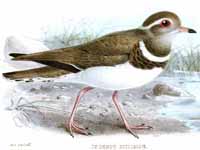

Plover,_Greater Sand Charadrius leschenaultii Found: Europe, Asia, Africa
The breeding male Greater Sand Plover has gray back; white underparts; chesnut nape, forehead, breast; black eye-mask; thick black bill; greenish legs. Female is duller. Nonbreeding lacks the chestnut.
Similar to: Lesser Sand Plover. Can be differentiated by size in a mixed flock. Greater Sand Plover has thicker bill.
Image by: 1) Brian_McCauley 2) Chung Kiu_and_Ryan Cheng 2, 4) Sergey Yeliseev 5) Changhua Coast ConservationSimilar to: Lesser Sand Plover. Can be differentiated by size in a mixed flock. Greater Sand Plover has thicker bill.
1, 2, 4) Nonbreeding 3) Breeding
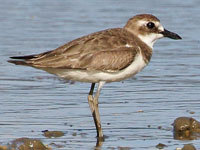
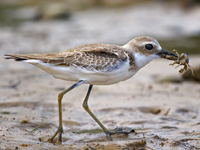

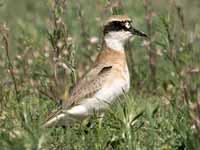
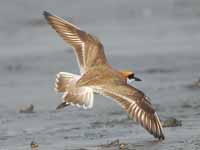
Plover,_Javan Charadrius javanicus Found: Indonesia
Image by: 1) Ron Knight 2) Francesco_Veronesi
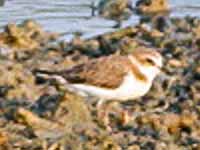
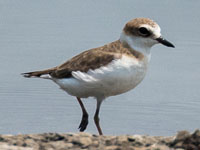
Plover,_Kittlitz's Charadrius pecuarius Found: Africa
The breeding Kittlitz;s Plover has gray-brown back, wings, crown; white forehead, throat; orange breast fading to white on lower belly; black line through eyes contining around the neck. Nonbreeding adult loose the distinctive face pattern but retain some orange on the breast.
Similar to: Snowy Plover. Nonbreeding Kittlitz's Plover similar to Snowy Plover but are smaller, longer legs; longer bill.
Image by: 1) Craig Adam - South Africa 2) Trevor Hardaker - South Africa 3) Charlie Westerinen - Hwange Park in Zimbabwe 4) Frans_Vandewalle - NamibiaSimilar to: Snowy Plover. Nonbreeding Kittlitz's Plover similar to Snowy Plover but are smaller, longer legs; longer bill.
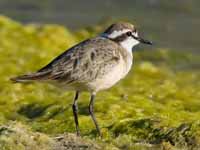
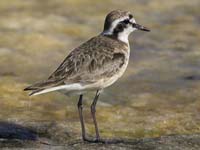
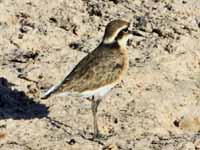
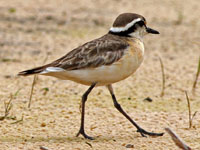
Plover,_Lesser Sand also Mongolian Plover Charadrius mongolus Found: North America (Alaska), Asia, Africa, Australia
The breeding male Lesser Sand Plover has gray back; white underparts; chesnut nape, forehead, breast; black eye-mask; black bill. Female is duller. Nonbreeding lacks the chestnut.
Similar to: Greater Sand Plover. Can be differentiated by size in a mixed flock. Greater Sand Plover has thicker bill.
Similar to: Oriental Plover. Lesser Sand Plover has whiter forehead than Oriental Plover. Oriental Plover is more elongated.
Similar to: Two Banded Plover. Ranges do not overlap.
Image by: 1) JJ Harrison 2, 3)
Lip Kee Yap- Sungei Buloh Wetland Reserve 4) Vedant_Kasambe - IndiaSimilar to: Greater Sand Plover. Can be differentiated by size in a mixed flock. Greater Sand Plover has thicker bill.
Similar to: Oriental Plover. Lesser Sand Plover has whiter forehead than Oriental Plover. Oriental Plover is more elongated.
Similar to: Two Banded Plover. Ranges do not overlap.
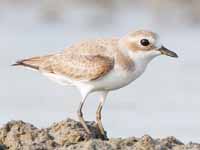
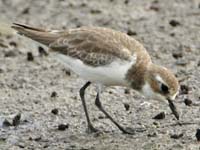
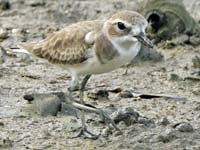
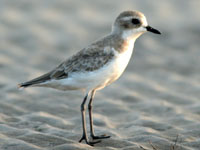
Plover,_Little Ringed Charadrius dubius Found: Europe, Asia, Africa
The Little Ringed Plover has gray-brown back, wings; brown cap; white forehead, throat, underparts; white neck collar with black neckband; black mask around the eyes; short dark bill; pink legs; yellow eye-ring.
Similar to: Ringed Plover. The Ringed Plover has wider black neckband; Little Ringed Plover has yellow eye-rings.
Image by: 1) Andreas Trepte 2) Frankie Chu 3) Karunakar Rayker - India 4) Graham Gavaghan Similar to: Ringed Plover. The Ringed Plover has wider black neckband; Little Ringed Plover has yellow eye-rings.

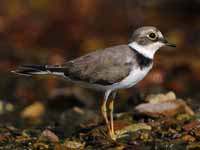
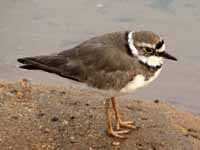
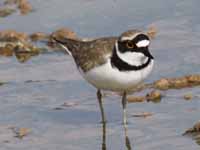
Plover,_Long-billed Charadrius placidus Found: Asia, Malaysia, Indonesia
The Long-billed Plover has gray-brown back, wings; brown cap; white forehead, throat, underparts; white neck collar with substantial black neckband; black forehead band; long thin black bill; orange legs.
Similar to: Ringed Plover. Ringed Plover has orange at base of bill; Long-billed Plover has all black bill which is also longer.
Image by: 1) nkenji 2) Andy Li 3) Hiyashi_HakaSimilar to: Ringed Plover. Ringed Plover has orange at base of bill; Long-billed Plover has all black bill which is also longer.
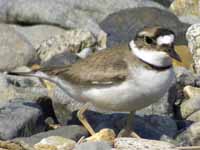
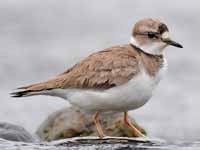

Plover,_Madagascar Charadrius thoracicus Found: Madagascar
The Madagascar Plover is the world's smallest plover. It has gray-brown upperparts, crown; white crown border; black eye-line, forehead border; white forehead, throat, underparts; black collar.
Image by: 1, 2, 3, 4) Dick Daniels - Morondava, Madagascar 5) Charles_J_Sharp



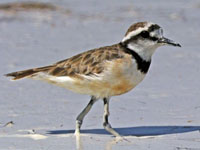
Plover,_Malaysian Charadrius peronii Found: southeast Asia, Indonesia, Malaysia, Philippines
The male Malaysian Plover has gray-brown upperparts; white underparts; white neck collar with black arcs below; black forehead band; black bill; gray legs. Female has pale chestnut rather than black forehead band and neck arcs.
Image by: 1) LonelyShrimp 2, 3) JJ Harrison - Thailand 3, 5) Lip Kee - Singapore 5) Jerry Oldenettel - Thailand1) Pair 2, 3) Female 4, 5, 6) Male
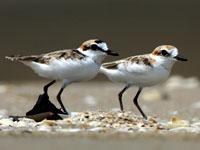
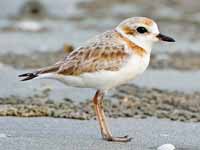
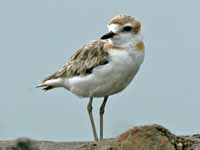
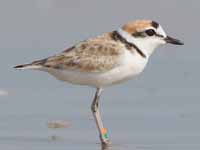

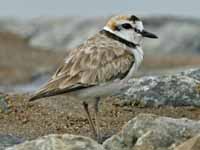
Plover,_Mountain Charadrius montanus Found: North America
The Mountain Plover has sandy brown upperparts; whitish face and underparts; black stripe from eye to crown (may be brown or lacking when nonbreeding. It likes prairies, not mountains!
The Mountain Plover prefers dry habitat with short grass or bare ground. And unlike most plovers
Similar to: nonbreeding American Golden Plover. Nonbreeding American Golden Plover has distinct spots on back.
Image by: 1) US Fish and Wildlife Service 2) Seabamirim 3) Ken Schneider - California 4) Bill_Bouton - CaliforniaThe Mountain Plover prefers dry habitat with short grass or bare ground. And unlike most plovers
Similar to: nonbreeding American Golden Plover. Nonbreeding American Golden Plover has distinct spots on back.
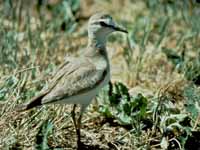
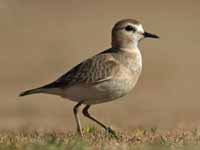
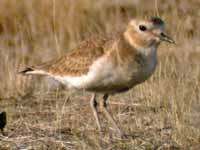
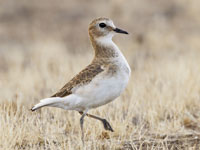
Plover,_Oriental Charadrius veredus Found: western Europe, Asia, Australasia
The nonbreeding Oriental Plover has brownish-buff upperparts, breast; white belly; off white supercilium, forehead; long black bill; yellowish legs. Breeding male has chestnut breast-band with black lower border. Breeding female like nonbreeding male but breast has rufous tinge.
Similar to: Lesser Sand Plover. Lesser Sand Plover has whiter forehead than Oriental Plover. Oriental Plover is more elongated.
Image by: 1, 2) Tom_Tarrant 3, 4) Ron Knight - West Timore Similar to: Lesser Sand Plover. Lesser Sand Plover has whiter forehead than Oriental Plover. Oriental Plover is more elongated.
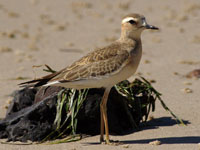
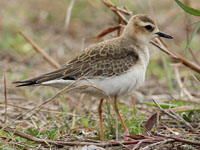
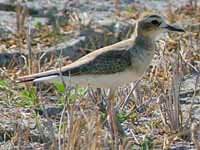

Plover,_Piping Charadrius melodus Found: North America
The breeding Piping Plover has sand colored upperparts; white underparts, forehead; black forehead band; white neck collar with black neckband; black bill with orange base; yellow-orange legs. Nonbreeding lacks black forehead band; lacks black neckband; has little orange on bill.
Similar to: Semipalmated Plover. Piping Plover is lighter in color than Semipalmated Plover and also more dainty in appearance.
Similar to: Snowy Plover. Adult Piping Plover has complete ring arong neck; Snowy Plover has partial ring around neck.
Image by: 1, 3 , 5, 6) Dick Daniels - North Carolina 2) Len Blumin - Connecticut
4) Mdf- OntarioSimilar to: Semipalmated Plover. Piping Plover is lighter in color than Semipalmated Plover and also more dainty in appearance.
Similar to: Snowy Plover. Adult Piping Plover has complete ring arong neck; Snowy Plover has partial ring around neck.
1, 2) Juvenile 3) Nonbreeding 4, 5, 6) Breeding
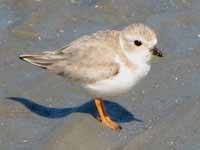
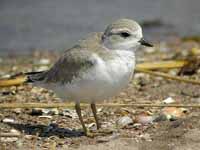
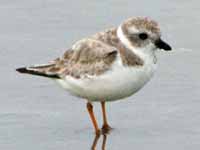
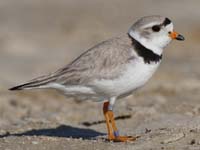
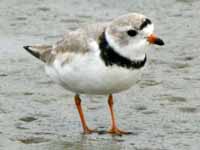
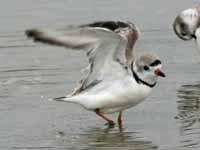
Plover,_Puna Charadrius alticola Found: Argentina, Bolivia, Chile, Peru
The Puna Plover is found near fresh water and salt water marshes. Black eye-line bands are connected via forehead. It has brownish-gray upperparts; white underparts.
Image by: 1) Carsten ten Brink - Chile 2) Paul_Balfe - Chile 3, 4) Cornell_Univ's_Neotropical_Birds_Online - Pio Marshall, Tor_Egil_Høgsas

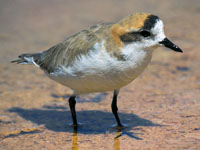

Plover,_Ringed also Common Ringed Plover Charadrius hiaticula Found: North America (northeast Canada), Europe, Asia, Africa
The Ringed Plover has gray-brown back, wings; brown cap; white forehead, throat, underparts; white neck collar with substantial black neckband; black forehead band; black bill with orange base; orange legs.
Similar to: Little Ringed Plover. The Ringed Plover has wider black neckband; Little Ringed Plover has yellow eye-rings.
Similar to: Long-billed Plover. Ringed Plover has orange at base of bill; Long-billed Plover has all black bill which is also longer.
Similar to: Semipalmated Plover. Ringed Plover and Semipalmated Plover were once consider part of thr same species. Differentiated by range, except for overlap in northeast Canada. Ringed Plover has 2 partially webbed toes; Semipalmated Plover has 3 partially webbed toes.
Image by: 1) Frans_Vandewalle - South Africa 2) Juan_Emilio - Canary Islands 3) Agustin_Povedano 4)
Andreas Trepte 5) Dick Daniels - Scotland 6) Cristiano Crolle - Texel, Holland 7) ArnoldiusSimilar to: Little Ringed Plover. The Ringed Plover has wider black neckband; Little Ringed Plover has yellow eye-rings.
Similar to: Long-billed Plover. Ringed Plover has orange at base of bill; Long-billed Plover has all black bill which is also longer.
Similar to: Semipalmated Plover. Ringed Plover and Semipalmated Plover were once consider part of thr same species. Differentiated by range, except for overlap in northeast Canada. Ringed Plover has 2 partially webbed toes; Semipalmated Plover has 3 partially webbed toes.
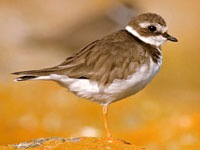

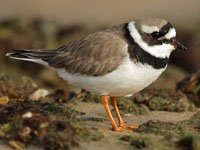
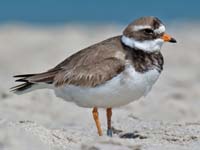
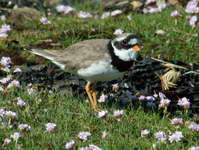
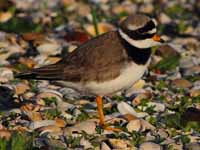
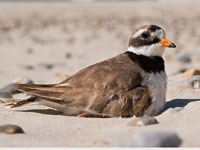
Plover,_Saint Helena also Wirebird Charadrius sanctaehelenae Found: island of St. Helena in south Atlantic Ocean
The Saint Helena Plover is the only bird endemic to St. Helena. It has thin black legs, hence the alternate name Wirebird.
Image by: 1) Andrew Neaum 2) Graham Ekins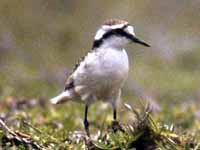
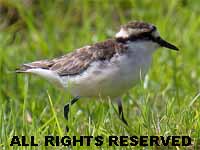
Plover,_Semipalmated Charadrius semipalmatus Found: The Americas
The breeding Semipalmated Plover has gray-brown back, wings; brown cap; white forehead, throat, underparts; white neck collar with black neckband; black forehead band; black bill with orange base; orange legs. Nonbreeding lacks black forehead band; has brown partial neckband; mostly black bill.
Similar to: Collared Plover. Semipalmated Plover has a thicker bill and is larger than the Collared Plover.
Similar to: Killdeer (juvenile). Killdeer has pink legs; Semipalmated Plover has yellowish legs. Killdeer usually found in fields and lawns; Semipalmated Plover usually found at the shore.
Similar to: Piping Plover. Piping Plover is lighter in color than Semipalmated Plover and also more dainty in appearance.
Similar to: Ringed Plover. Ringed Plover and Semipalmated Plover were once consider part of thr same species. Differentiated by range, except for overlap in northeast Canada. Ringed Plover has 2 partially webbed toes;.Semipalmated Plover has 3 partially webbed toes.
Similar to: Wilson's Plover. Wilson's plover is slightly larger than the Semipalmated Plover and has a considerably larger bill.
Image by: 1, 2, 3, 4, 5, 6, 7, 8, 9, 10) Dick Daniels - North Carolina 11) Nick Athanas - PanamaSimilar to: Collared Plover. Semipalmated Plover has a thicker bill and is larger than the Collared Plover.
Similar to: Killdeer (juvenile). Killdeer has pink legs; Semipalmated Plover has yellowish legs. Killdeer usually found in fields and lawns; Semipalmated Plover usually found at the shore.
Similar to: Piping Plover. Piping Plover is lighter in color than Semipalmated Plover and also more dainty in appearance.
Similar to: Ringed Plover. Ringed Plover and Semipalmated Plover were once consider part of thr same species. Differentiated by range, except for overlap in northeast Canada. Ringed Plover has 2 partially webbed toes;.Semipalmated Plover has 3 partially webbed toes.
Similar to: Wilson's Plover. Wilson's plover is slightly larger than the Semipalmated Plover and has a considerably larger bill.
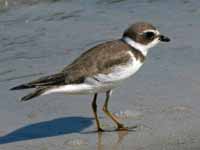
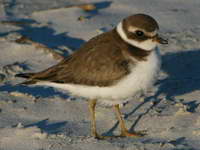
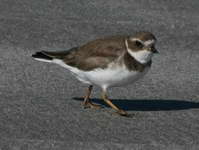
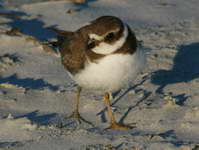
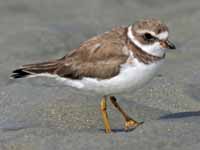
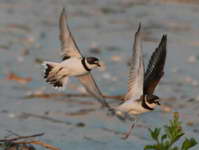
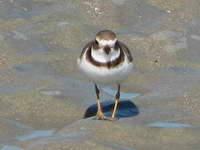
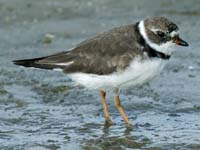
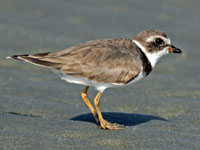

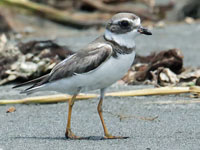
Plover,_Snowy also Kentish Plover Charadrius alexandrinus Found: The Americas, Europe, Japan
The breeding Snowy Plover has gray-brown upperparts; white underparts; white neck collar with black arcs below; black forehead band; black bill; gray legs. Nonbreeding lacks black forehead band; has pale neck arcs.
Similar to: Collared Plover. Snowy Plover is paler above than the Collared Plover and has dark legs.
Similar to: Kittlitz's Plover. Nonbreeding Kittlitz's Plover similar to Snowy Plover but are smaller, longer legs; longer bill.
Similar to: Piping Plover. Adult Piping Plover has complete ring arong neck; Snowy Plover has partial ring around neck.
Image by: 1) Mke Baird - California 2) Len Blumin 3) Andy_Morffew. 4) Bogbumper - Spain
5, 6, 7) Dick Daniels - Half Moon Bay, California 8) Dick - ChileSimilar to: Collared Plover. Snowy Plover is paler above than the Collared Plover and has dark legs.
Similar to: Kittlitz's Plover. Nonbreeding Kittlitz's Plover similar to Snowy Plover but are smaller, longer legs; longer bill.
Similar to: Piping Plover. Adult Piping Plover has complete ring arong neck; Snowy Plover has partial ring around neck.
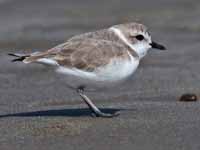
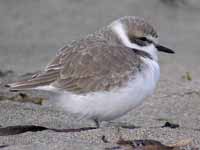
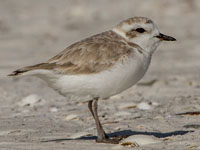
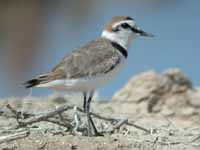
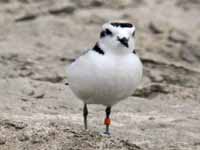
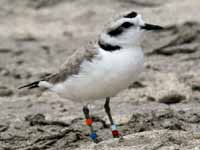


Plover,_Three-banded Charadrius tricollaris Found: eastern and southern Africa, Madagascar
The Three-banded Plover has brown upperparts; gray face; white forehead, lowerparts, supercilium which extends along nape; black then white then black bands on breast; red eye-ring; red bill with black end.
Similar to: Forbes's Plover. Three-banded Plover has white forehead; Forbes's Plover has gray forehead. Ranges do not overlap much.
Similar to: Killdeer. Ranges do not overlap.
Image by: 1) Alastair Rae - the Masai Mara
2) Arno Meintjes 3) Derek_Keats - South Africa 4, 5. 6 Dick - KenyaSimilar to: Forbes's Plover. Three-banded Plover has white forehead; Forbes's Plover has gray forehead. Ranges do not overlap much.
Similar to: Killdeer. Ranges do not overlap.
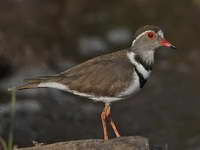
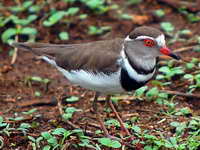
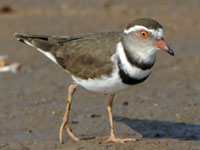



Plover,_Two-banded Charadrius falklandicus Found: South America
The breeding Two-banded Plover has dark brown upperparts; white forehead, underparts; two dark brown breast bands. The dark browns become garyish-browns in nonbreeding birds.
Similar to: Lesser Sand Plover. Ranges do not overlap.
Image by: 1, 5) Nick Athanas - Argentina 2) Cláudio Timm - Rio Grande do Sul, Brazil 3) David_Montolio 4) Richard Crook - ChileSimilar to: Lesser Sand Plover. Ranges do not overlap.
1) Juvenile 2) Nonbreeding 3, 4, 5) Breeding
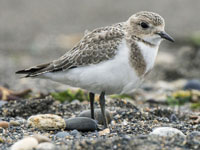
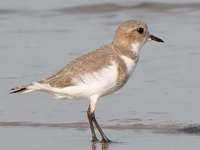



Plover,_White-fronted Charadrius marginatus Found: Africa (south of the Sahara)
The breeding White-fronted Plover has medium brown upperparts; white forehead, throat, underparts; black eye-line, black frontal bar to crown; white underparts with variable buff wash to breast; black bill; yellowish-gray legs. Non-breeding adults are grayer than breeding adults; black head markings replaced by gray. Frontal bar is absent in some females. It feeds actively with fast runs like a Sanderling.
Image by: 1) Brian_Ralphs 2) Frans_Vandewalle - South Africa 3, 4) Ian White - South Africa and Botswana 5) Dick Daniels - Morondava, Madagascar 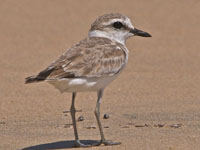
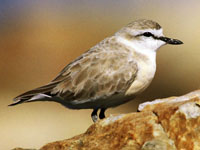
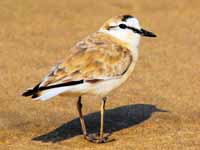
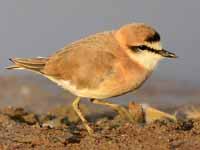

Plover,_Wilson's Charadrius wilsonia Found: The Americas
The breeding Wilson's Plover has gray upperparts; white forehead, throat, underparts; white neck collar with black neckband; relatively long black bill; pink legs. Nonbreeding has gray partial neckband.
Similar to: Killdeer (juvenile). Killdeer usually found in fields and lawns; Wilson's Plover usually found at the shore.
Similar to: Semipalmated Plover. Wilson's plover is slightly larger than the Semipalmated Plover and has a considerably larger bill.
Image by: 1) Nick Athanas - Brazil 2) Len Blumin - Fort De Soto Park, Florida 3, 4, 5, 6, 7, 8) Dick Daniels - North Carolina Similar to: Killdeer (juvenile). Killdeer usually found in fields and lawns; Wilson's Plover usually found at the shore.
Similar to: Semipalmated Plover. Wilson's plover is slightly larger than the Semipalmated Plover and has a considerably larger bill.
4, 5) Breeding female 6, 7, 8) Breeding male
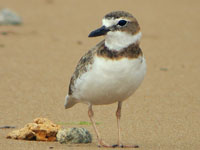
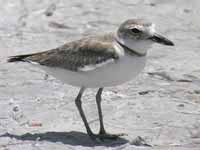
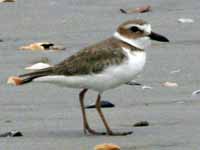
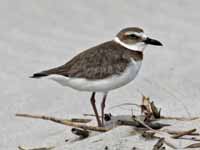
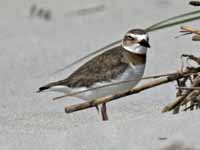
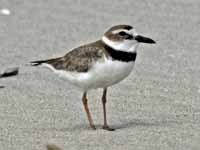
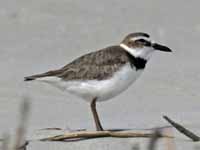
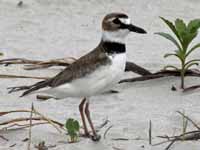
Genus Elseyornis - 1 species
Dotterel,_Black-fronted Elseyornis melanops Found: Found: Australia
The Black-fronted Dotterel has brown upperparts with dark wing stripe; white face with wide black eye-line; white underparts; plunging black neckband; red bill tipped with black; red eye-ring.
Similar to: Inland Dotterel. Black-fronted Dotterel has horizontal black eye-line; Inland Dotterel has vertical black eye-line.
Image by: 1) JJ_Harrison 2) Jason Girvan 3 Oystercatcher 4) Laurie_Boyle Similar to: Inland Dotterel. Black-fronted Dotterel has horizontal black eye-line; Inland Dotterel has vertical black eye-line.

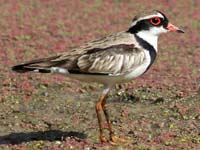
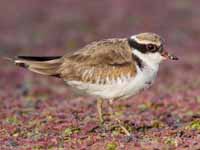
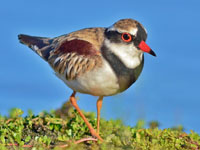
Genus Erythrogonys - 1 species
Dotterel,_Red-kneed Erythrogonys cinctus Found: Found: Australasia
The Red-kneed Dotterel has brown back, wings; black hood, nape, breast band; white throat, belly; brown-gray legs with red knees.
Similar to: Hooded Plover. Hooded Plover has black throat; Red-kneed Dotterel has white throat.
Image by: 1, 2) Laurie_Boyle 3) Patrick_K59 - Australia 4) Leo Similar to: Hooded Plover. Hooded Plover has black throat; Red-kneed Dotterel has white throat.
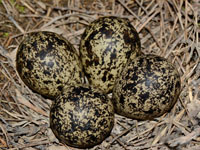
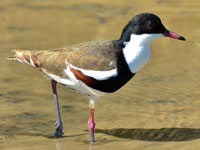
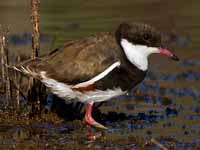

Genus Oreopholus - 1 species
Dotterel,_Tawny-throated Oreopholus ruficollis Found: South America
The Tawny-throated Dotterel has grayish-brown upperparts, neck; whitish supercilium, forehead, throat; black bill, eye-line; tawny throat; gray underparts with black patch on belly.
Image by: 1) Mark Peck - Chile 2, 3) Nick Athanas - Argentina, Chile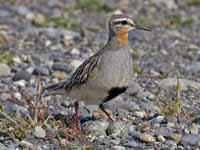
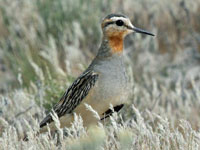
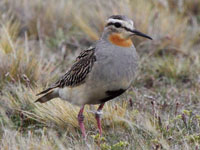
Genus Phegornis - 1 species
Plover,_Diademed Phegornis mitchellii Found: South America
The Diademed Plover has black lower head; white stripe surrondning crown; chestnut crown, rear-neck; white throat; some barring on breast; gray belly.
Image by: 1) Opisska - Argentina 2, 3
Inao - Chile 4) Nick Athanas - Chile 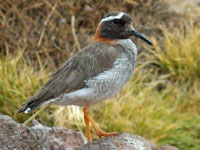
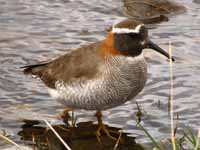
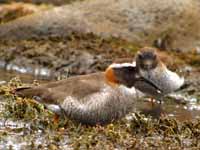
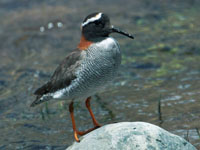
Genus Pluvialis
In breeding plumage these medium sized plovers have mainly black underparts, and golden or silvery upperparts. They have relatively short bills and feed mainly on insects, worms or other invertebrates which are obtained by a run-and-pause technique. They hunt by sight, rather than by feel.
Plover,_American Golden- Pluvialis dominica Found: The Americas
The breeding American Golden Plover has black and gold spotted upperparts; black face and throat with white border; black underparts. Nonbreeding has drab back and wings; gray breast; white supercilium, belly.
Similar to: Black-bellied Plover. Amerian Golden-Plover is more golden than Black-bellied Plover.
Similar to: Mountain Plover. Nonbreeding American Golden Plover has distinct spots on the back.
Similar to: Pacific Golden-Plover. American Golden-Plover wings extend further beyond tail than do wings of Pacific Golden-Plover. Pacific Golden Plover has more white along the flanks.
Image by: 1, 2)
Cláudio Timm - Rio Grande do Sul, Brazil 3) OW Johnson USFWS 4) Dick Daniels - National Aviary Similar to: Black-bellied Plover. Amerian Golden-Plover is more golden than Black-bellied Plover.
Similar to: Mountain Plover. Nonbreeding American Golden Plover has distinct spots on the back.
Similar to: Pacific Golden-Plover. American Golden-Plover wings extend further beyond tail than do wings of Pacific Golden-Plover. Pacific Golden Plover has more white along the flanks.
1, 2Female / nonbreeding male 3, 4) Breeding male
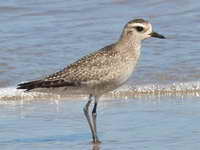
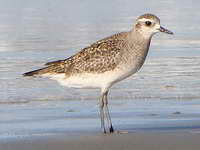
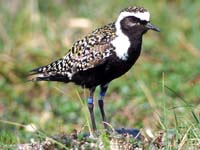
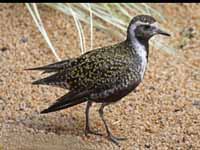
Plover,_Black-bellied also Grey Plover Pluvialis squatarola Found: The Americas, Europe, Asia, Africa, Australasia
The breeding Black-bellied Plover has black and white spotted upperparts; black face, throat, and underparts with white border; black legs, bill. Nonbreeding has brownish-gray back and head; faint brown upper breast; white supercilium, lower breast, belly; gray legs, bill.
Similar to: American Golden-Plover, European Golden-Plover, Pacific-Golden Plover. Golden-Plovers more golden than Black-bellied Plover.
Image by: 1, 3, 5, 6, 7, 8) Dick Daniels - North Carolina 2) Dick - California 4) Peter Wallack Similar to: American Golden-Plover, European Golden-Plover, Pacific-Golden Plover. Golden-Plovers more golden than Black-bellied Plover.
1 - 3) Non-breeding plumage 4 - 7) Breeding plumage
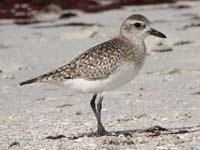
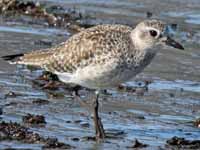
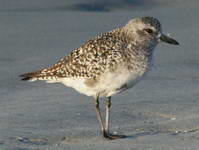
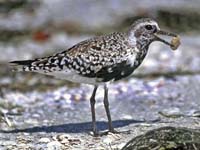
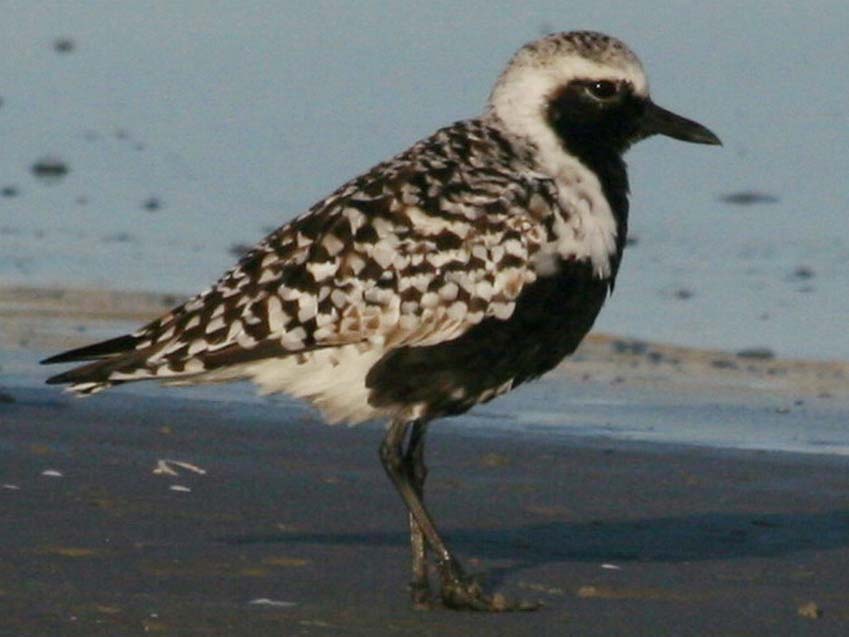
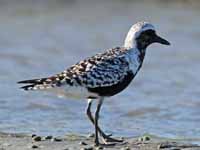
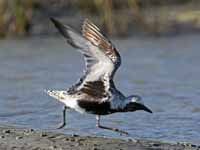
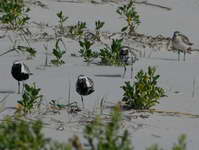
Plover,_European Golden- Pluvialis apricaria Found: Europe, Asia, Africa
The breeding European Golden Plover has black and gold spotted upperparts; black face and throat with white border that extends to the flanks ; black underparts.
Similar to: Black-bellied Plover. European Golden-Plover is more golden than Black-bellied Plover.
Similar to: Eurasian Dotterel. Eurasian Dotterel is smaller and more compact than European Golden Plover.
Image by: 1) Antje_Schultner 2) Tony_Morris 3) Lip_kee - Singapore 4) Bjørn Christian Tørrissen - Norway 5) Goldregenpfeifer 6) Stefan_Berndtsson 7) Andrej_Chudý Similar to: Black-bellied Plover. European Golden-Plover is more golden than Black-bellied Plover.
Similar to: Eurasian Dotterel. Eurasian Dotterel is smaller and more compact than European Golden Plover.
1 - 3) Nonbreeding 4 - 6) Breeding
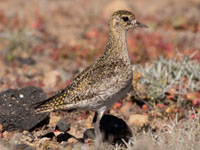
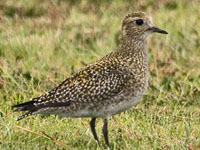
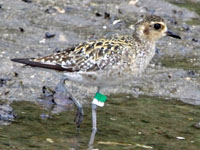
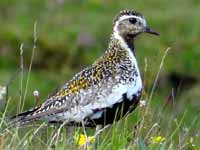
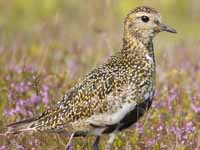
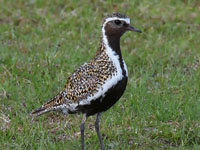
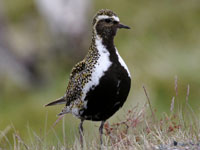
Plover,_Pacific Golden- Pluvialis fulva Found: North America, Europe, Asia, Africa, Australasia
The breeding Pacific Golden Plover has black and gold spotted upperparts; black face and throat with white border that extends to the flanks ; black underparts. Nonbreeding has drab back and wings; gray breast; white supercilium, belly.
Similar to: American Golden-Plover. American Golden-Plover wings extend further beyond tail than do wings of Pacific Golden-Plover.
Similar to: Black-bellied Plover. Pacific Golden-Plover is more golden than Black-bellied Plover. Pacific Golden Plover has more white along the flanks.
Image by: 1, 2) Dick Daniels - Kauai, Hawaii 3) Laurie_Boyle - Australia 4, 5, 6) Chris Queen - Kauai, Hawaii 7) OW
Johnson, USFWS Similar to: American Golden-Plover. American Golden-Plover wings extend further beyond tail than do wings of Pacific Golden-Plover.
Similar to: Black-bellied Plover. Pacific Golden-Plover is more golden than Black-bellied Plover. Pacific Golden Plover has more white along the flanks.

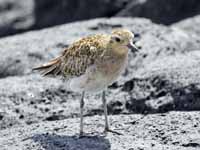

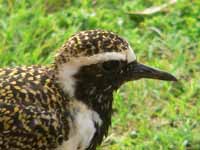
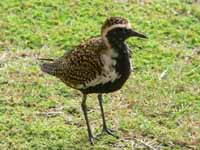
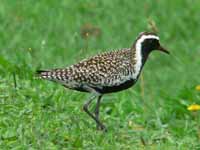
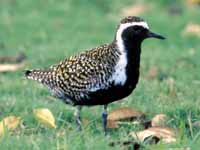
Genus Thinornis
Plover,_Hooded also Fantail Plover also Hooded Dottterel Thinornis rubricollis Endemic to Australia
The Hooded Plover has pale gray-brown back; black hooded head; white partial collar; white breast, belly; red bill with dark tip; red eye-ring; orange legs. Adult males and females are similar.
Similar to: Red-kneed Dotterel. Hooded Plover has black throat; Red-kneed Dotterel has white throat.
Image by:1) Wayne Butterworth - Kilcunda 2, 5) Laurie_Boyle 3) JJ Harrison - Tasmania, Australia 4, 6) Benjamint444 - southeastern Australia Similar to: Red-kneed Dotterel. Hooded Plover has black throat; Red-kneed Dotterel has white throat.
1) Family

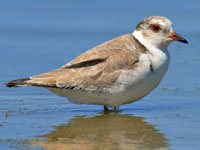
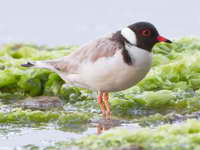
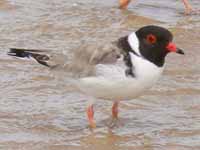

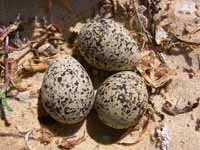
Plover,_Shore also Shore Dotterel Thinornis novaeseelandiae Found: New Zealand
The Shore Plover are the only plovers that nest in burrows. There are only about 200 birds. They are being introduced into pest free islands of New Zealand to help preserve the species.
Image by: 1, 4) GusMonkeyBoy 2) Steve Attwood 3) Eric De Leeuw1) Juvenile 2) Female 3, 4) Male
